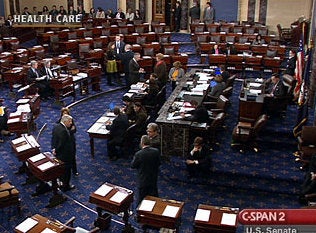
On Friday, Senators Maria Cantwell (D-WA) and Susan Collins (R-ME) released the Carbon Limits and Energy for American Renewal (CLEAR) Act that auctions permits to fuel producers and returns 75% of the resulting revenue in checks to every American. With its "cap and dividend" approach, this bill would help the U.S. make a fair, affordable transition to a clean-energy, low-carbon economy, and avoid the pitfalls of other climate bills that pander to the coal-burning utilities and Wall Street traders.
Here's how the Cantwell-Collins bill works. The Department of Energy would sell "carbon shares" (see my note below about terminology) to the upstream companies that import and produce oil, gas and coal fuels into the US economy. The annual number of permits issued by the government would decrease by 83 percent by 2050, and would have a price between a minimum of $7/ton and a maximum of $21/ton of COe in 2012, increasing each year. This "price collar" prevents the volatility that beset the European Emissions Trading System in its early years, and provides some measure of price certainty for companies to plan their investments in clean energy technologies.
Auctioning 100 percent of permits is great, but even better is the consumer dividend to maintain widespread support for the program, and help households as the new price signal is passed down to them in their fuel and electricity purchases. The bill returns 75 percent of net auctions proceeds directly to every legal resident of the U.S. on a monthly basis through the Federal government's Electronic Funds Transfer system. The other 25 percent of auction proceeds will be used to fund investment into clean energy development, regionally-specific assistance for communities and workers transitioning to a clean energy economy, energy efficiency programs, assistance to low-income families, and other reductions in non-CO greenhouse gases.
Cantwell-Collins (CLEAR) versus Waxman-Markey (ACES)
How does the 39-page CLEAR Act compare to the 1,428 page bill that squeaked out of the House on June 26, referred to as Waxman-Markey, the American Clean Energy and Security Act of 2009 (ACES), or H.R. 2454?
The two bills differ in many ways, but here are some of the big ones:
•Auctioning 100 percent (CLEAR) versus mostly free allowances (ACES)
•Upstream regulation (CLEAR: the well heads, mines and importers of fossil fuels) versus mid-stream regulation (ACES: the power stations and energy intensive industries)
•Offsets policy (in CLEAR, offset projects cannot be used as a substitute for reductions under the cap, while ACES includes billions offsets, an amount that could swamp near-term reductions)
•Limitations on derivatives trading (CLEAR prohibits such trading, ACES doesn't)
ACES earned its reputation as a complicated cap-and-trade bill by scattering free allowances to dozens of causes, including electric utilities (local distribution companies), "clean coal," adaptation, and deficit reduction. Although some of the causes are worthy, others are questionable. ACES, as well as its Senate counterpart known as Boxer-Kerry, Clean Energy Jobs and American Power Act (CEJ), or S.1733, rely on LDCs to shield consumers, rather than returning the money directly back to people. To give the CEJ a boost, Senators Kerry, Graham, and Lieberman have been working on a framework that adds concessions such as offshore drilling and nuclear power. Kudos to Graham for at least coming to the table, but at some point their effort will stop being about saving the climate, and become just another subsidy to the fossil fuel industry.
By contrast, CLEAR's mantra is "simplicity, transparency and equity." It sends a much clearer price signal to regulated businesses, is revenue-neutral to the government, and provides economic stimulus through dividends to households.
Some groups have already invested a lot into ACES, but for those who think the ACES train has already left the station, check out this quote from AARP, which has entered the climate debate on behalf of its elderly membership living on a fixed income:
"On behalf of AARP and its 40 million members, we thank Senators Cantwell and Collins for their continued leadership on environmental and consumer issues and commend you for introducing the CLEAR Act. AARP believes that reducing harmful carbon dioxide is an important national goal, but it should not be achieved by imposing significant new burdens on American households. The CLEAR Act offers a simple, straightforward approach for reducing carbon emissions in a manner that will mitigate energy cost increases and minimize administrative costs for consumers."
--Dean Sagar, Director, Livable Communities, Government Relations and Advocacy, AARP
One quick note on terminology: The CLEAR Act's definition of "carbon shares" is the right to place 1 ton of CO emissions into the atmosphere. It's basically a permit. Previously, the term "Carbon Share" has referred to a per capita portion of the overall emissions cap, denominated in tons CO, and allocated directly to people. For example, individuals would receive a share representing 14 tons CO in the mail or electronically on a debit card. People would sell their "share" to the regulated upstream companies. In this way, the sale of shares accomplishes the same goal as dividends: compensating consumers. Consumers could choose to receive either dividends or shares through a check box on their tax form. At this point, the CLEAR Act does not contain such a provision, but it does provide a great starting point for further discussion, and it represents an exciting next step forward in the Senate's climate debate.
